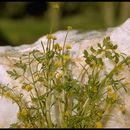Comprehensive Description
(
Inglês
)
fornecido por North American Flora
Sanicula bipinnata H. & A. Bot. Beech. Voy. 347. 1838
Sanicula pinnalifida Torr. U. S. Expl. Exp. 17: 314. 1874.
Plants erect, 1-6 dm. high, perennial from an elongate fusiform root, the stem slender, the herbage strongly aromatic; leaves linear-oblong to ovate in general outline, excluding the petioles 3.5-8.5 cm. long, 3-3.5 cm. broad, 2-3-pinnate, the ultimate divisions obovate to oblong, 4—10 mm. long, 2-11 mm. broad, distinct, entire to lobed, serrate; petioles wholly sheathing; eauline leaves with linear ultimate divisions; involucre of leaflike bracts; involucel of several, entire, linear, subscarious, distinct or connate bractlets shorter than the heads; fertile rays 3-5, 1.5-9 cm. long, the umbels axillary and terminal, the umbellets capitate, 3-7 mm. broad; sterile and fertile flowers in the same umbellet; flowers yellow; calyx cleft to below the middle, the lobes deltoid, acute, shorter than the petals; anthers yellow, exserted; styles exceeding the bristles; fruit subglobose to obovoid, 2-3 mm. long, 2-3 mm. broad, shortlypedicellate, tuberculate, the tubercles with short, stout bristles; oiltubes large, 3-5 on the dorsal and lateral surfaces, 2 on the commissure; seed subterete in cross section, the commissural face deeply concave.
Type locality: California, Douglas.
Distribution: Hills and valleys, cismontane California (Baker 4775, Heller 10,707).
- citação bibliográfica
- Albert Charles Smith, Mildred Esther Mathias, Lincoln Constance, Harold William Rickett. 1944-1945. UMBELLALES and CORNALES. North American flora. vol 28B. New York Botanical Garden, New York, NY
Sanicula bipinnata
(
Inglês
)
fornecido por wikipedia EN
Sanicula bipinnata is a species of plant in the family Apiaceae known by the common name poison sanicle.[1] It is endemic to California where it is found in low-elevation mountains and foothills, especially in the hills along the coast. It occurs in the California Coastal Range and Sierra Nevada foothills,[2] including Ring Mountain, California.[3]
Description
It is recognizable as a relative of the carrots and parsnips with its thin stalk topped with small umbels of yellow or cream flowers. The origin of its poisonous reputation is unknown.[4] Yet despite the name, there are no current records of its toxicity in humans, though it or a related species might be toxic to horses or other stock animals.[5] It was called wene by the Miwok and used to treat venomous bites from snakes, perhaps providing a reason for the common name in English. Though they used other sanicles in the same manner.[6] The Karuk called the plant ikxash and traditionally ate the young leaves as a green, indicating the toxic reputation is undeserved.[7]
References
-
^ a b Hassler M. (2017). World Plants: Synonymic Checklists of the Vascular Plants of the World (version May 2017). In: Roskov Y., Abucay L., Orrell T., Nicolson D., Bailly N., Kirk P.M., Bourgoin T., DeWalt R.E., Decock W., De Wever A., Nieukerken E. van, Zarucchi J., Penev L., eds. (2017). Species 2000 & ITIS Catalogue of Life, 25 August 2017. Digital resource at http://www.catalogueoflife.org/col/details/species/id/0054e07bc6de616db2c0cfa775d9659f . Species 2000: Naturalis, Leiden, the Netherlands. ISSN 2405-8858.
-
^ Jepson Manual. 1993 Jepson Manual Treatment: Sanicula bipinnata; University of California Press, Berkeley, Ca.
-
^ Hogan, C. Michael (2008). Burnham, Andy (ed.). Ring Mountain. The Megalithic Portal.
-
^ Burrows, George E.; Tyrl, Ronald J. (2013). "8 Apiaceae" (PDF). Toxic Plants of North America (2nd ed.). John Wiley & Sons, Inc. p. 54. ISBN 978-0-8138-2034-7. OCLC 829352587. Retrieved 22 January 2016. "As its common name implies, Sanicula bipinnata (poison sanicle) has a reputation of toxicity of unknown origin."
-
^ Fuller, Thomas C.; McClintock, Elizabeth May (1986). "Angiosperms: Dicotyledons". Poisonous Plants of California. California natural history guides. Vol. 53. University of California Press. p. 74. ISBN 978-0520055681. OCLC 13009854. Retrieved 22 January 2016. "There are no current records of the toxicity of this species, but the common name poison sanicle is found in all the references. In 1917, when horses were more commonly utilized, P. B. Kennedy stated that some if not all species of Sanicula are poisonous to stock, particularly horses."
-
^ Barrett, Samuel Alfred; Gifford, Edward Winslow (1997). "Foods and Medicines: The Uses of Plants: Medicines" (PDF). Miwok Material Culture: Indian Life of the Yosemite Region. Yosemite Association. p. 168. Retrieved 22 January 2016. "Poison Sanicle (Sanicula bipinnata H. & A.). Wene (C). This plant was boiled and applied to snake bite."
-
^ Schenck, Sara M.; Edward Winslow, Gifford (1952). "Karok Ethnobotany". University of California Anthropological Records. 13 (6): 386, 392. Sanicula bipinnata, poison sanicle, Karok ikxash. The young greens are eaten.

- licença
- cc-by-sa-3.0
- direitos autorais
- Wikipedia authors and editors
Sanicula bipinnata: Brief Summary
(
Inglês
)
fornecido por wikipedia EN
Sanicula bipinnata is a species of plant in the family Apiaceae known by the common name poison sanicle. It is endemic to California where it is found in low-elevation mountains and foothills, especially in the hills along the coast. It occurs in the California Coastal Range and Sierra Nevada foothills, including Ring Mountain, California.
- licença
- cc-by-sa-3.0
- direitos autorais
- Wikipedia authors and editors

